Concealed Carry Crime Stats 2024: The Impact of Open Carry on Crime in the U.S.
As of early 2024, twenty-nine states in the United States allow individuals to carry firearms without a permit. Sixteen of these states have adopted permitless carry laws since 2019. This trend has sparked interest in how allowing concealed carry impacts crime rates.
Overall, permitless carry does not appear to increase crime rates. Some states have seen decreases in crime, while others have experienced no significant change. Notably, three of the five safest states in the country allow permitless carry.
Sixteen of the 29 states with permitless carry passed their laws after 2021, with seven of those passing them after 2015. (Source 1)
Ten of the sixteen states that adopted permitless carry before 2022 saw a decline in violent crime rates; only Alaska saw a notable increase. (Source 4)
States like Arizona, Alaska, and Wyoming, with permitless carry for over ten years, generally saw reduced long-term violent crime rates. (Source 4)
In 2022, states with restrictive concealed carry laws had an average homicide rate of 5.4 per 100,000, compared to 5.8 per 100,000 in states with permitless carry. (Source 3)
States with concealed carry laws have not seen an increase in crime rates; many have seen declines in violent crime and homicide rates. (Source 3)
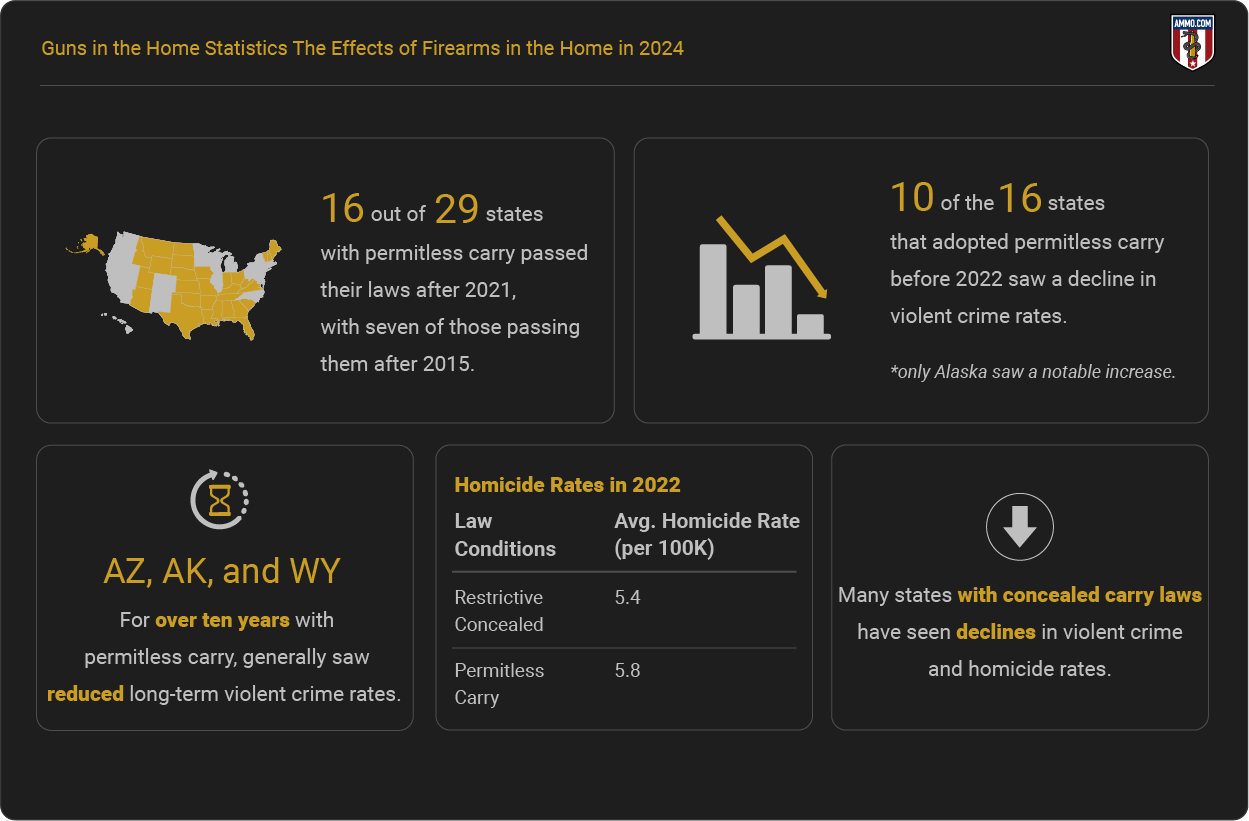
Understanding Concealed Carry and Crime Rates
Concealed carry refers to state laws that allow individuals to carry firearms without a state-issued permit, provided they aren't legally prohibited (e.g., felons, individuals with domestic violence convictions, a history of mental illness, or substance abuse).
Concealed carry laws vary widely from state to state. Some states allow open carry, where firearms must be visible, while others permit only concealed carry, where firearms must not be visible. Additionally, some states have a combination of both regulations. Despite these variations, all states with concealed carry options also provide concealed carry permits to citizens.
Theoretically, concealed carry laws aim to create a level playing field between law-abiding citizens and potential threats. Criminals and violent individuals are unlikely to comply with permit requirements, so restrictions may primarily hinder lawful citizens' ability to bear arms for self-defense.
Concerns about the impact of concealed carry on crime rates are common. It's important to note that legal permission to carry doesn't necessarily mean widespread firearm carrying. Recent surveys indicate that only a small fraction of gun owners in the United States, approximately 2.02 million out of 112 million, regularly carry firearms. (Source 2)
While there's no evidence that concealed carry laws increase crime rates, the lack of noticeable decreases in crime rates in some states might be due to the low percentage of Americans who carry firearms daily.
States with Concealed Carry
Twenty-eight states have passed concealed carry legislation since 2000, and Vermont has never required permits. (Source 1)
Sixteen of the 29 states with permitless carry passed their laws during or after 2021, with seven passing them after 2015.
Alaska, Arizona, and Wyoming have allowed permitless carry for over a decade, while South Carolina and Louisiana’s laws will take effect in mid-2024. (Source 4)
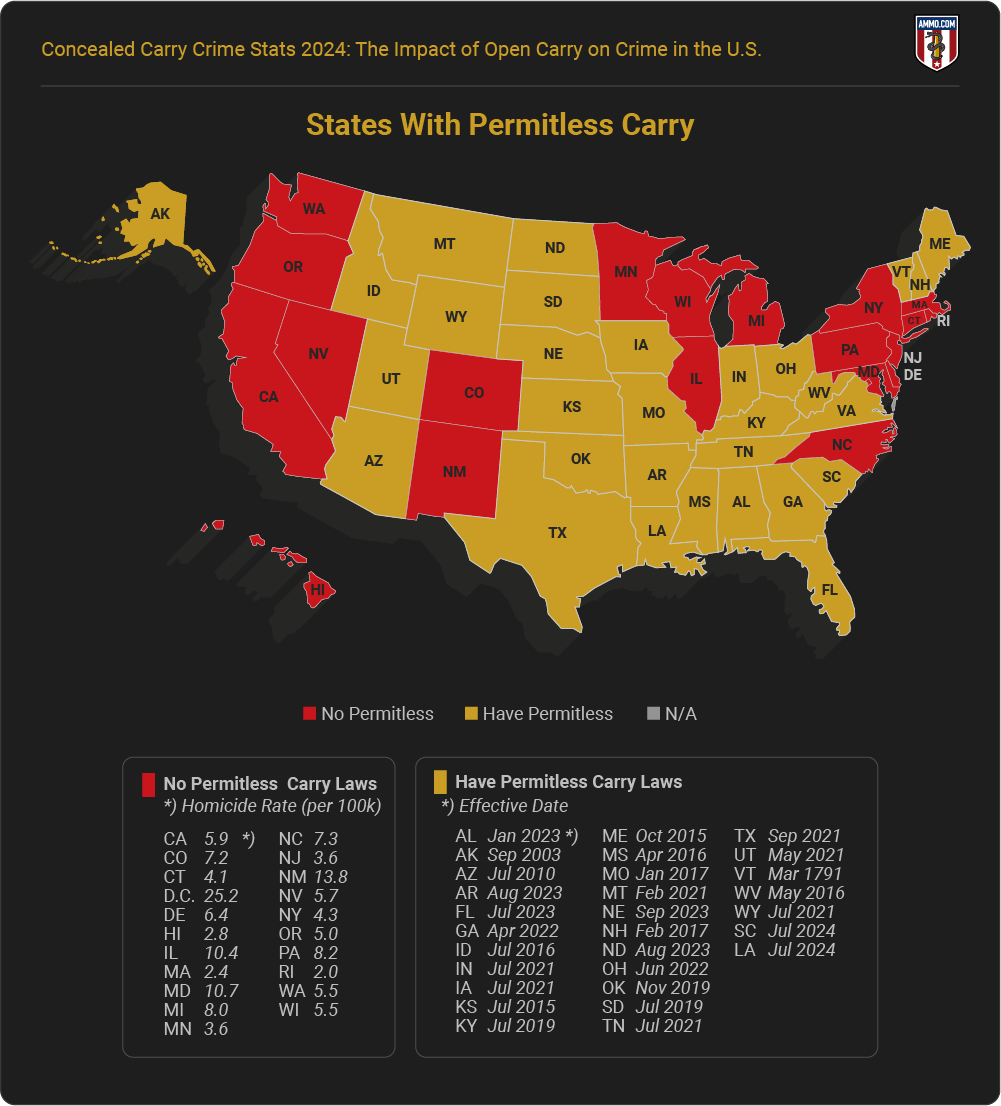
[Graphic Source: Concealed Carry and Reciprocity]
Concealed Carry and Violent Crime Rates
Ten of the sixteen states that passed constitutional carry legislation before 2022 have seen a decline in violent crime rates, with Alaska being the only state to experience a notable increase.
Although violent crimes include many offenses and personal weapons (like fists and feet) are more commonly used than firearms, concealed carry laws can still impact violent crime rates.
Theoretically, when individuals feel empowered to defend themselves, criminals have fewer potential victims, leading to a natural decline in violent crime rates. Let's examine the violent crime rates before and after states passed concealed carry legislation.
New Hampshire saw the sharpest decline in violent crime rates, dropping from 199.8 per 100,000 people before permitless carry legislation to 125.6 per 100,000 after. Tennessee, Missouri, and Maine also experienced substantial decreases, with fewer than thirty people being victimized per 100,000. (Source 4)
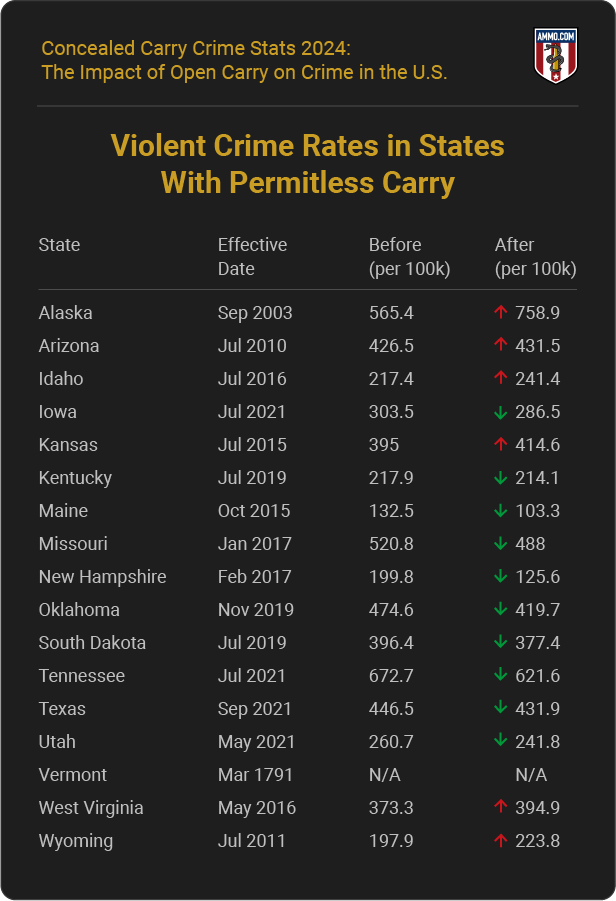
[Graphic Source: FBI Crime Data Explorer]
Violent Crime Over Time
States rarely see substantial long-term increases or decreases in crime. Newspaper articles from 1850 highlight Chicago's crime problems, much like today's coverage.
To understand the impact of permitless carry laws, we can examine the states that passed these laws before 2010, providing twenty years of crime data to analyze.
By comparing the ten-year average violent crime rates before and after the adoption of permitless carry, we can gain a clearer picture of crime trends. Let's look at the data.
Arizona, Alaska, and Wyoming are the only states that passed permitless carry more than ten years ago. So, let’s dive in.
Note: Vermont has never required permits to carry and consistently has low violent crime rates. Therefore, this analysis does not include it since there is no period without concealed carry legislation.
Alaska
Although Alaska's violent crime rate increased to 758.9 per 100,000 in 2022, the overall trend over a longer period shows a decrease in violent crime rates after the implementation of Constitutional Carry laws. Specifically:
- Before Constitutional Carry laws were enacted in 2003, the ten-year average violent crime rate was 673.33 per 100,000.
- After the laws were enacted, the ten-year average violent crime rate decreased to 638.76 per 100,000.
This indicates that while there was a significant increase in violent crime in 2022, the general trend over the decade following the law's implementation was a reduction in violent crime rates.
Arizona
Although Arizona's violent crime rate in 2022 was slightly higher than in 2010, the overall trend over a longer period shows a significant decrease in violent crime rates after the implementation of Constitutional Carry laws. Specifically:
- In 2022, the violent crime rate was 431.5 per 100,000, which is close to the rate of 426.5 per 100,000 in 2010, the year before the law was passed.
- The average violent crime rate over the ten years before 2010 was higher, at 512.89 per 100,000.
- In the decade following the adoption of Constitutional Carry, the average violent crime rate decreased to 444.56 per 100,000.
This indicates that despite slight fluctuations, the overall trend after the law's implementation was a reduction in violent crime rates.
Wyoming
Wyoming experienced a decrease in its long-term violent crime rates after passing Concealed Carry legislation in 2011. Specifically:
- In the year before the legislation was passed, the violent crime rate was 197.9 per 100,000.
- The average violent crime rate over the ten years before the legislation was 243.11 per 100,000.
- After the legislation was implemented, the ten-year average violent crime rate decreased to 219.22 per 100,000.
This indicates that the overall trend was a reduction in violent crime rates following the adoption of Concealed Carry legislation.
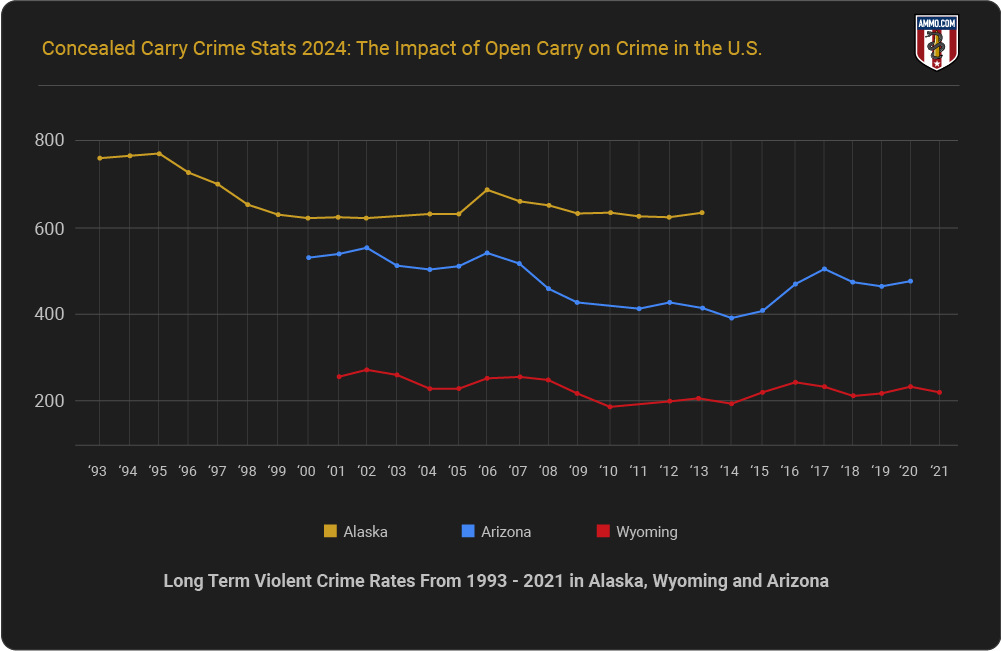
[Graphic Source: FBI Crime Data Explorer]
Concealed Carry and Homicide Rates
In 2022, states that required concealed carry permits had lower homicide rates. The average homicide rate in these restrictive states was 5.4 per 100,000, compared to 5.8 per 100,000 in states with permitless carry.
Many proponents of Constitutional Carry argue that allowing people to carry firearms without a permit might lead to more homicides. However, this view does not address the underlying causes of criminality and homicide.
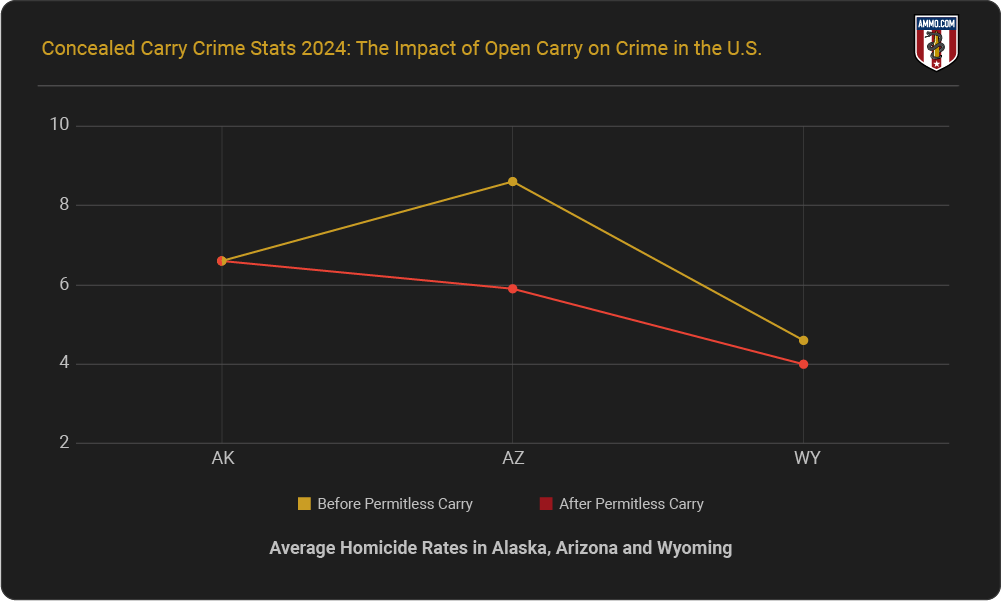
[Graphic Source: CDC Wonder Database]
Homicides, Concealed Carry, and Historical Trends
The relationship between concealed carry laws and homicide rates is inconsistent and does not show a clear pattern.
- Vermont has never required concealed carry permits and has low homicide rates.
- Georgia has required permits since 1976 but has had high homicide rates since 1968.
- Maine, North Dakota, and South Dakota, which began issuing permits in 1980, have consistently low homicide rates, while Florida has high homicide rates.
- California, New York, and Illinois show no consistent relationship between concealed carry laws and homicide rates. California and New York had high homicide rates in the 1980s and 1990s that declined in the 2000s, despite long-standing permit requirements. Illinois banned concealed carry but still has high homicide rates.
Overall, concealed carry laws do not seem to have a clear impact on homicide rates. Other factors, such as habitual offender legislation passed in the mid-1990s, appear to have played a significant role in reducing homicide rates during that decade.
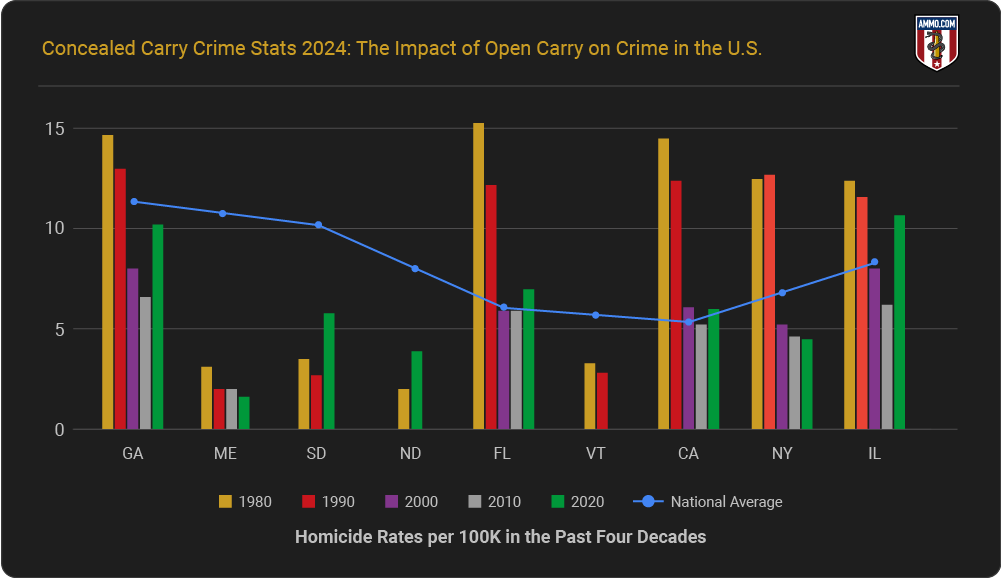
[Graphic Source: CDC Wonder Database]
Effects of Concealed Carry on Long-Term Homicide Rates
Similar to the previous section, states that implemented concealed carry legislation more than a decade ago either have lower homicide rates today or did not experience an increase.
- Alaska’s ten-year homicide average remained the same at 6.6 per 100,000 before and after the legislation.
- Arizona’s ten-year average declined from 8.6 per 100,000 to 5.9 per 100,000.
- Wyoming’s ten-year homicide average declined from 4.6 per 100,000 to 4 per 100,000.
For states that recently passed concealed carry legislation (between 2019 and 2022), there was no immediate, consistent change in homicide rates attributable to the legislation. However, during these years, there was a general increase in homicides across most states, regardless of whether they had permitless carry laws. This suggests that other factors may have influenced the rise in homicides during that period.
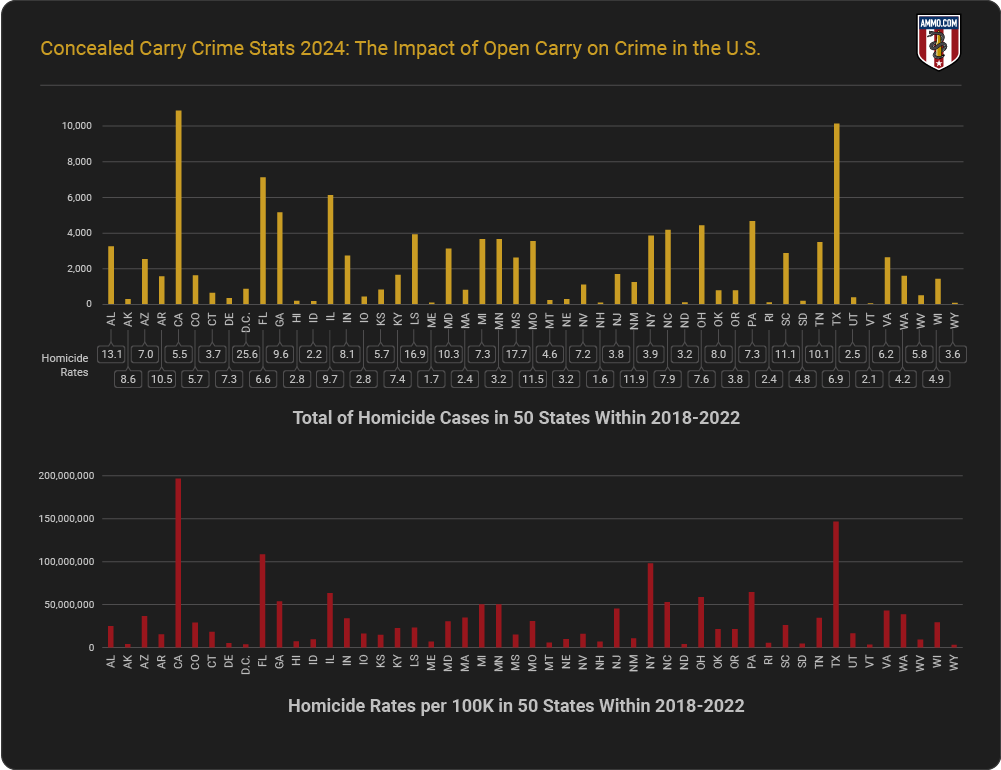
[Graphic Source: CDC Wonder Database & FBI Crime Data Explorer]
Concealed Carry: A Crime Deterrent
Despite concerns from various groups, concealed carry laws do not increase crime rates. States with such laws have often experienced declines in violent crime and homicide rates. Concealed carry legislation does not make it easier for individuals to obtain firearms; it simply allows those who are already legally permitted to carry to do so without additional government intervention. Overall, there have been few, if any, negative effects from concealed carry legislation.
Sources
- Concealed Carry and Reciprocity
- National Firearms Survey (Defensive Use)
- CDC Wonder
- FBI Crime Data Explorer
Infographics
- Are Guns & Ammo The New Gold? Why More Americans Are Arming Themselves
- The Greatest Gun Salesman In America: President Barack Obama
- Shooting Straight: How Both Presidential Candidates Have Changed On Gun Control
- President Obama: (Still) The Greatest Gun Salesman in America
- An Inconvenient Truth: How The Obama Administration Became Earth's Largest Arms Dealer
- Armed Drones: President Obama's Weapon of Choice
- COVID-19 Data Study: Ammunition Sales Continue to Soar in Response to Coronavirus Panic
- Data Study: 18 Months of Ammo Sales during a Pandemic, Protests, and the Biden Presidency
- Data Study: U.S. Ammo Sales Surge Following Russian Invasion of Ukraine
- Most Gun-Friendly States in 2024
- Worst States to be a Gun Owner (2024 Updated)
- Children & Firearms: Definitions and Demographics Make All the Difference
- Urban Violent Crime & Legal Gun Ownership
- Gun-Free School Zone Laws & School Shootings (2024 Updated)
- Gun Control Laws and Enforcement Trends 2024
- Gun Ownership by State (2024 Statistics)
- How Many Gun Owners are in America? (2024 Statistics)
- Concealed Carry Crime Stats 2024
- Accidental Shooting Statistics: A Review of Unintentional Firearm Deaths from 1979-2024
- America’s Stolen Guns: A Silent Contributor to Gun Crimes in the U.S. (2024)
- Gun Violence Statistics 2024: Comprehensive Look at the Data
- Gun Laws vs. Crime Rates in 2024: A Comprehensive Analysis
- Gun Death Statistics by Caliber: A Review of Calibers and Crime in 2024
- Anti-Gun Control Arguments 2024: Facts Gun Control Lobby Suppress
- Guns in the Home Statistics: The Effects of Firearms in the Home in 2024
- Gun Deaths in the US: Analyzing At-Risk Demographics in 2024
- How Many Guns in the U.S.: All About America’s Firearms in 2024
- Gun Facts in the U.S. 2024: The Reality of Firearms in America
- Defensive Gun Use Statistics: America’s Life-Saving Gun Incidents (2024)
- Correlation Between Mass Shootings and Prescription Drugs (2024 Study)
- Gun Ownership by Gender in 2024: Closing the Gender Gap
- Murders by Weapon Type: September 2024 Statistics
- Gun Violence Among Black Americans: September 2024 Statistics
- The Ultimate Hunting Caliber Chart: Best Cartridge Per Species
- How Old Do You Have to be to Buy a Gun: A State Guide 2024
- Most Popular Guns in the U.S.: The Must-Have Guns in 2024
- Stray Bullet Deaths: Accident and Injury Statistics in September 2024
- Mass Shooters by Race: Demographics of Assailants 1966-2024
- Ammunition Limits By State in 2024: How Much Ammo Can You Buy?
- Why Do Americans Own Guns in 2024?
- How Many Americans Want Stricter Gun Laws in 2024?
- How Many Households in the U.S. Have a Gun in 2024?
- What Percentage of Gun Deaths are Suicides in 2024?
- Average Age of Mass Shooters in the U.S.
- Firearm Ownership in America by Year
- US Firearms Deaths Per Year: A Collective Report 1968-2024
- Percentage of Americans Owning Guns in 2024
- Texas Gun Ownership: Total Numbers, Trends, and Most Popular Guns
- Gun Ownership Statistics Colorado 2025: Trends & Numbers
- Hunting Accident Statistics 2025 (Causes & Trends Per Year)
- Banned Guns & Ammo List: A 2025 Review by State
- 3D Printed Gun Laws By State
- How To Build a Home Shooting Range: The Ultimate Guide
- States With the Highest Murder Rates
- Best Self-Defense Weapons for Women
